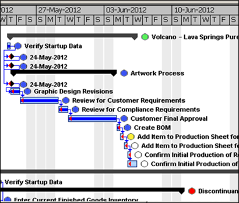Mastering Product Development Process Management


Product development process management is critical to your success. We’re drowning in complexity these days. Complex products mean complex data, which require a complex network of people to plan, design, develop, manufacture, deliver and support. How do you coordinate all these pieces? How do you take control of the complexity?
I’ve been reading through some of the customer case studies for PLM process management. While the approach might vary, in the end the most successful companies are able to harness the power of product development process management to master complexity.
When we talk about product development process management, we’re talking about tying together DATA + PEOPLE + PROCESS. Some strategies might include basic process automation, while other involve program and project management solutions for coordinating more complex projects and processes, such as product change management. Let’s take a closer look at these strategies for product development process management.
Automating manual processes
The first step to taking control of DATA + PEOPLE + PROCESS is eliminating manual processes. One of the first companies I worked with had folders that were passed around the office (not computer files – actual yellow folders!).When you finished your assignment, you put your stuff in the folder, signed it, passed it to the next person. I’ve worked with customers who follow the same basic procedure, but use email and shared drives to get work done. In today’s complex world, this model can’t keep up.
Product development process management software can help to automate manual tasks and processes. You can define workflows or work processes that match YOUR business processes. Campagnolo is a great example of a company that started by converting their legacy paper-based processes to electronic form. Then they gradually modified, enhanced, and optimized them. Everyone involved in the processes gets what they need to get their job done at the right time – no more searching for missing information, or working on outdated material! Fokker Services is another company that has automated their processes to manage engineering change that meets strict Aerospace and Defense requirements. They report “Where we previously used expensive and slow paper procedures, we have now implemented all the processes in a transparent manner…”.With automated processes, managers have access to information that provides a real-time view of status. Now you can see where your bottlenecks are and continuously improve your processes to streamline even more!
Coordinated projects and programs
Automating manual processes is the right first step to taking control of product development process management. However, in many cases, it’s not enough. Managers or team leaders are often responsible for more than one project. They have to coordinate many different processes. The first attempt at controlling this complexity is often stand-alone project management. When you manage tasks and deliverables separate from the system where the work and deliverables are actually being done, you create an environment where people are wasting time reconciling information between systems, manually updating status, and constantly searching for the information they need to get their job done.

There are many advantages to a product development process management strategy that includes project management INSIDE your PLM system. The first is that you are providing team leaders and managers the capability to manage project in the same system they use every day. Another advantage (and most powerful in my opinion!) is that you can tie data and workflows to the task itself. That means that when a task starts, you can automatically route any reference and deliverable information to the people working on and completing the task. Pöttinger uses project management capabilities in PLM and reports “you get all the mechanisms for providing information to those who need it when and where they need it”.
In addition, when a task is completed, the project timeline automatically updates, and the deliverables are linked and tracked. .Just imagine if every person in your processes had what they needed to get their job done and every project manager had instant, up-to-date visibility into the project! Shaangu Power also uses PLM to manage projects: “We have improved efficiency, simplified processes and task allocation standards, and can now share project information immediately. Importantly, Teamcenter also enables us to quickly obtain feedback about task completion, order distribution and execution.”
Product development process management is a topic with many different approaches and benefits. I have recruited some of my favorite product managers in this space to help me talk about various aspects. Is there something you’ve heard us introduce at an event? Something you like to know more about? Drop me a note and let me know!


